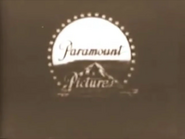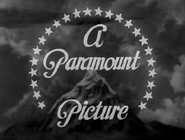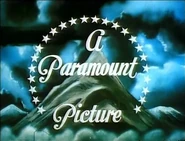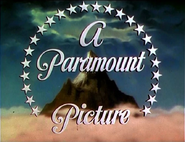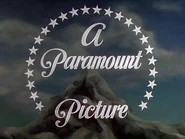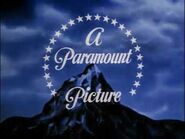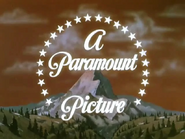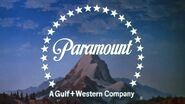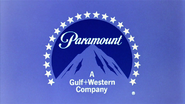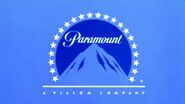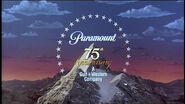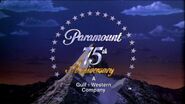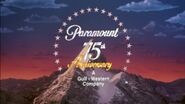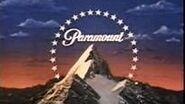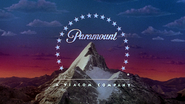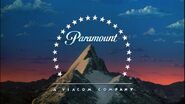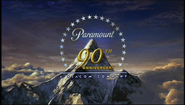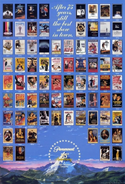
Paramount Pictures (also known as Paramount Pictures Corporation) is a film and television production/distribution company founded in 1912 and currently owned by media conglomerate Paramount Global. It is the third oldest existing film studio in the world behind Universal Studios & Gaumont Pictures, and the last major film studio still headquartered in the Hollywood district of Los Angeles. Paramount is consistently ranked as one of the largest top-grossing movie studios. Paramount Pictures is a member of the Motion Picture Association of America (MPAA).
History[]
1912–1920: Early history[]
Paramount is the fifth oldest surviving film studio in the world behind Universal Studios, Nordisk Film, Pathé, and Gaumont Film Company. It is the last major film studio still headquartered in the Hollywood district of Los Angeles.
Paramount Pictures dates its existence from the 1912 founding date of the Famous Players Film Company. However, Famous Players was actually only one of the companies that merged into Paramount Pictures (then known as the Famous Players-Lasky Corporation) in 1914. Founder Hungarian-born Adolph Zukor, who had been an early investor in nickelodeons, saw that movies appealed mainly to working-class immigrants. With partners Daniel Frohman and Charles Frohman he planned to offer feature-length films that would appeal to the middle class by featuring the leading theatrical players of the time (leading to the slogan "Famous Players in Famous Plays"). By mid-1913, Famous Players had completed five films, and Zukor was on his way to success.
That same year, another aspiring producer, Jesse L. Lasky, opened his Lasky Feature show Company with money borrowed from his brother-in-law, Samuel Goldfish, later known as Samuel Goldwyn. The Lasky company hired as their first employee a stage director with virtually no film experience, Cecil B. DeMille, who would find a suitable location site in Hollywood, near Los Angeles, for his first feature film, The Squaw Man.
Beginning in 1914, both Lasky and Famous Players released their films through a start-up company, Paramount Pictures Corporation, organized early that year by a Utah theatre owner, W. W. Hodkinson, who had bought and merged several smaller firms. Hodkinson and actor, director, producer Hobart Bosworth had started production of a series of Jack London movies. Paramount was the first successful nation-wide distributor; until this time, films were sold on a state-wide or regional basis which had proved costly to film producers. Also, Famous Players and Lasky were privately owned while Paramount was a corporation.
In 1916, Zukor maneuvered a three-way merger of his Famous Players, the Lasky Company, and Paramount. Zukor and Lasky bought Hodkinson out of Paramount, and merged the three companies into one. The new company Lasky and Zukor founded, Famous Players-Lasky Corporation, grew quickly, with Lasky and his partners Goldwyn and DeMille running the production side, Hiram Abrams in charge of distribution, and Zukor making great plans. With only the exhibitor-owned First National as a rival, Famous Players-Lasky and its "Paramount Pictures" soon dominated the business.
1921–1930: The rise[]
Because Zukor believed in stars, he signed and developed many of the leading early stars, including Mary Pickford, Marguerite Clark, Pauline Frederick, Douglas Fairbanks, Gloria Swanson, Rudolph Valentino, and Wallace Reid. With so many important players, Paramount was able to introduce "block booking", which meant that an exhibitor who wanted a particular star's films had to buy a year's worth of other Paramount productions. It was this system that gave Paramount a leading position in the 1920s and 1930s, but which led the government to pursue it on antitrust grounds for more than twenty years.
The driving force behind Paramount's rise was Zukor. All through the teens and twenties, he built the Publix Theatres Corporation, a mighty chain of nearly 2,000 screens, ran two production studios (in Astoria, New York, and Hollywood, California), and became an early investor in radio, taking a 50% interest in the new Columbia Broadcasting System in 1928 (selling it within a few years; this would not be the last time Paramount and CBS crossed paths, as time proved). By acquiring the successful Balaban & Katz chain in 1926, he gained the services of Barney Balaban (who would eventually become Paramount's president in 1936), his brother A. J. Balaban (who would eventually supervise all stage production nationwide and produce talkie shorts), and their partner Sam Katz (who would run the Paramount-Publix theatre chain in New York City from the thirty-five story Paramount Theatre Building on Times Square). Zukor also hired independent producer B. P. Schulberg, an unerring eye for new talent, to run the new West Coast operations. They would then purchase what was originally built as the Robert Brunton Studios. This 26 acre facility, at 5451 Marathon Street, cost US$1 million. In 1927, Famous Players-Lasky took on the name Paramount-Famous Lasky Corporation. Three years later, because of the importance of the Publix Theatres, it became Paramount-Publix Theatres Corporation.
Also in 1928, Paramount began releasing Inkwell Imps animated cartoons produced by Max and Dave Fleischer's Fleischer Studios in New York City. The Fleischers, veterans in the animation industry, would prove to be among the few animation producers capable of challenging the prominence of Walt Disney. The Paramount newsreel series Paramount News ran from 1927 to 1957. In 1929 Paramount Released their first musical "Innocents of Paris" Richard A. Whiting and Leo Robin composed the score for the film, Maurice Chevalier starred and sung the most famous song from the film "Louise".
1931–1940: Receivership[]
Eventually, Zukor shed most of his early partners; the Frohman brothers, Hodkinson and Goldwyn were out by 1917 while Lasky hung on until 1932, when, blamed for the near-collapse of Paramount in the Depression years, he too was tossed out. Zukor's over-expansion and use of overvalued Paramount stock for purchases led the company into receivership in 1933. A bank-mandated reorganization team, led by John Hertz and Otto Kahn kept the company intact, and, miraculously, Zukor was kept on. In 1935, Paramount-Publix went bankrupt. In 1936, Barney Balaban became president, and Zukor was bumped up to chairman of the board. In this role, Zukor reorganized the company as Paramount Pictures, Inc. and was able to successfully bring the studio out of bankruptcy.
As always, Paramount films continued to emphasize stars; in the 1920s there were Swanson, Valentino, and Clara Bow. By the 1930s, talkies brought in a range of powerful new draws: Miriam Hopkins, Marlene Dietrich, Mae West, W.C. Fields, Jeanette MacDonald, Claudette Colbert, the Marx Brothers (whose first two films were shot at Paramount's Astoria, New York, studio), Dorothy Lamour, Carole Lombard, Bing Crosby, band leader Shep Fields, famous Argentine tango singer Carlos Gardel, and Gary Cooper among them. In this period Paramount can truly be described as a movie factory, turning out sixty to seventy pictures a year. Such were the benefits of having a huge theater chain to fill, and of block booking to persuade other chains to go along. In 1933, Mae West would also add greatly to Paramount's success with her suggestive movies She Done Him Wrong and I'm No Angel. However, the sex appeal West gave in these movies would also lead to the enforcement of the Production Code, as the newly formed organization the Catholic Legion of Decency threatened a boycott if it was not enforced.
Paramount cartoons produced by Fleischer Studios continued to be successful, with characters such as Betty Boop and Popeye the Sailor becoming widely successful. One Fleischer series, Screen Songs, featured live-action music stars under contract to Paramount hosting sing-alongs of popular songs. However, a huge blow to Fleischer Studios occurred in 1934, after the Production Code was enforced and Betty Boop's popularity declined as she was forced to have a more tame personality and wear a longer skirt. The animation studio would rebound with Popeye, and in 1935, polls showed that Popeye was even more popular than Mickey Mouse. After an unsuccessful expansion into feature films, as well as the fact that Max and Dave Fleischer were no longer speaking to one another, Fleischer Studios was acquired by Paramount, which renamed the operation Famous Studios. That incarnation of the animation studio continued cartoon production until 1967, but has been historically dismissed as having largely failed to maintain the artistic acclaim the Fleischer brothers achieved under their management.
1941–1950: United States v. Paramount Pictures, Inc.[]
In 1940, Paramount agreed to a government-instituted consent decree: block booking and "pre-selling" (the practice of collecting up-front money for films not yet in production) would end. Immediately Paramount cut back on production, from sixty-plus pictures to a more modest twenty annually in the war years. Still, with more new stars like Bob Hope, Alan Ladd, Veronica Lake, Paulette Goddard, and Betty Hutton, and with war-time attendance at astronomical numbers, Paramount and the other integrated studio-theatre combines made more money than ever. At this, the Federal Trade Commission and the Justice Department decided to reopen their case against the five integrated studios. Paramount also had a monopoly over Detroit movie theaters through subsidiary company United Detroit Theaters as well. This led to the Supreme Court decision United States v. Paramount Pictures, Inc. (1948) holding that movie studios could not also own movie theater chains. This decision broke up Adolph Zukor's creation and effectively brought an end to the classic Hollywood studio system.
1951–1966: Split and after[]
With the separation of production and exhibition forced by the U.S. Supreme Court, Paramount Pictures Inc. was split in two. Paramount Pictures Corporation was formed to be the production distribution company, with the 1,500-screen theater chain handed to the new United Paramount Theaters on December 31, 1949. Leonard Goldenson, who had headed the chain since 1938, remained as the new company's president. The Balaban and Katz theatre division was spun off with UPT; its trademark eventually became the property of the Balaban and Katz Historical Foundation. The Foundation has recently acquired ownership of the Famous Players Trademark. Cash-rich and controlling prime downtown real estate, Goldenson began looking for investments. Barred from film-making by prior anti-trust rulings, he acquired the struggling ABC television network in February 1953, leading it first to financial health, and eventually, in the mid-1970s, to first place in the national Nielsen ratings, before selling out to Capital Cities in 1985 (Capital Cities would eventually sell out, in turn, to The Walt Disney Company in 1996). United Paramount Theaters was renamed ABC Theaters in 1965 and was sold to businessman Henry Plitt in 1974. The movie theater chain was renamed Plitt Theaters. In 1985, Cineplex Odeon Corporation merged with Plitt. In later years, Paramount's TV division would develop a strong relationship with ABC, providing many hit series to the network.
The DuMont fiasco[]
Paramount Pictures had been an early backer of television, launching experimental stations in 1939 in Los Angeles and Chicago. The Los Angeles station eventually became KTLA, the first commercial station on the West Coast. The Chicago station got a commercial license as WBKB in 1943, but was sold to UPT along with Balaban & Katz in 1948 and was eventually resold to CBS as WBBM-TV.
In 1938, Paramount bought a stake in television manufacturer DuMont Laboratories. Through this stake, it became a minority owner of the DuMont Television Network. However, Paramount proved to be a timid and obstructionist partner. Its minority stake hampered DuMont's efforts to expand. The FCC counted KTLA and WBKB as DuMont O&O stations, even though the former was only an affiliate in 1947 and the latter never carried a DuMont program. Since DuMont already owned three stations, the FCC did not allow DuMont to buy any more stations as long as Paramount owned a portion of DuMont. However, Paramount refused to sell. Also Paramount launched its own network, Paramount Television Network, in 1948 through its television unit, Television Productions, Inc. It also refused to help DuMont as it sank during the 1950s. Paramount management planned to acquire additional owned-and-operated stations ("O&Os"); the company applied to the FCC for additional stations in San Francisco, Detroit, and Boston. The FCC, however, denied Paramount's applications. A few years earlier, the federal regulator had placed a five-station cap on all television networks: no network was allowed to own more than five VHF television stations. Paramount was hampered by its minority stake in the DuMont Television Network. Although both DuMont and Paramount executives stated that the companies were separate, the FCC ruled that Paramount's partial ownership of DuMont meant that DuMont and Paramount were in theory branches of the same company. Since DuMont owned three television stations and Paramount owned two, the federal agency ruled neither network could acquire additional television stations. The FCC requested that Paramount relinquish its stake in DuMont, but Paramount refused. According to television historian William Boddy, "Paramount's checkered anti-trust history" helped convince the FCC that Paramount controlled DuMont. Both television networks suffered as a result, with neither company able to acquire five O&Os. Meanwhile, CBS, ABC, and NBC had each acquired the maximum of five stations by the mid-1950s.
When ABC accepted a merger offer from UPT in 1953, DuMont quickly realized that ABC now had more resources than it could possibly hope to match. It quickly reached an agreement in principle to merge with ABC. However, Paramount vetoed the deal in part due to an earlier FCC ruling that Paramount controlled DuMont, as well as concerns that UPT was still a Paramount subsidiary. Within two years of the failed ABC deal, DuMont was no more.
In 1951, Paramount bought a stake in International Telemeter, an experimental pay TV service which operated with a coin inserted into a box. The service began operating in Palm Springs, California on November 27, 1953, but due to pressure from the FCC, the service ended on May 15, 1954.
With the loss of the theater chain, Paramount Pictures went into a decline, cutting studio-backed production, releasing its contract players, and making production deals with independents. By the mid-1950s, all the great names were gone; only C.B. DeMille, associated with Paramount since 1913, kept making pictures in the grand old style. Despite Paramount's losses, DeMille would, however, give the studio some relief and create his most successful film at Paramount, a 1956 remake of his 1923 film The Ten Commandments. Like some other studios, Paramount saw little value in its film library (see below for more info on the early Paramount library). DeMille died in 1959.
1966–1970: Early Gulf+Western era[]
By the early 1960s, Paramount's future was doubtful. The high-risk movie business was wobbly; the theater chain was long gone; investments in DuMont and in early pay-television came to nothing. Even the flagship Paramount building in Times Square was sold to raise cash, as was KTLA (sold to Gene Autry in 1964 for a then-phenomenal $12.5 million). Founding father Adolph Zukor (born in 1873) was still chairman emeritus; he referred to chairman Barney Balaban (born 1888) as "the boy." Such aged leadership was incapable of keeping up with the changing times, and in 1966, a sinking Paramount was sold to Charles Bluhdorn's industrial conglomerate, Gulf + Western Industries Corporation. Bluhdorn immediately put his stamp on the studio, installing a virtually unknown producer named Robert Evans as head of production. Despite some rough times, Evans held the job for eight years, restoring Paramount's reputation for commercial success with The Odd Couple, Love Story, The Godfather, Chinatown, and Rosemary's Baby.
Gulf + Western Industries also bought the neighboring Desilu television studio (once the lot of RKO Pictures) from Lucille Ball in 1967. Using some of Desilu's established shows such as Star Trek, Mission: Impossible, and Mannix as a foot in the door at the networks, the newly reincorporated Paramount Television (now Paramount Television Studios) eventually became known as a specialist in half-hour situation comedies.
1971–1980: CIC formation and high-concept era[]
In 1970, Paramount teamed with Universal Studios to form Cinema International Corporation, a new company that would distribute films by the two studios outside the United States. Metro-Goldwyn-Mayer would become a partner in the mid-1970s. Both Paramount and CIC entered the video market with Paramount Home Video (now Paramount Home Entertainment) and CIC Video, respectively.
Robert Evans abandoned his position as head of production in 1974; his successor, Richard Sylbert, proved to be too literary and too tasteful for Gulf + Western's Bluhdorn. By 1976, a new, television-trained team was in place headed by Barry Diller and his "Killer-Dillers", as they were called by admirers or "Dillettes" as they were called by detractors. These associates, made up of Michael Eisner, Jeffrey Katzenberg, Dawn Steel and Don Simpson would each go on and head up major movie studios of their own later in their careers.
The Paramount specialty was now simpler. "High concept" pictures such as Saturday Night Fever and Grease hit big, hit hard and hit fast all over the world,[citation needed] and Diller's television background led him to propose one of his longest-standing ideas to the board: Paramount Television Service, a fourth commercial network. Paramount Pictures purchased the Hughes Television Network (HTN) including its satellite time in planning for PTVS in 1976. They also hired Rich Frank of KCOP-TV and a member of the Operation Prime Time steering committee. But neither the board nor Bluhdorn himself accepted Diller's repeated advancements of this idea and neither did Bluhdorn's successor, Martin Davis. Paramount sold HTN to Madison Square Garden in 1979. But Diller believed strongly in the concept, and so took his fourth-network idea with him when he moved to 20th Century Fox in 1984, where Fox's then freshly installed proprietor, Rupert Murdoch was a more interested listener. Meanwhile, concentrating on hot films, Paramount was met with critical success with the release of The Godfather, based on the popular novel.
However, the television division would be playing catch-up for over a decade after Diller's departure in 1984 before launching its own television network – UPN – in 1995. Lasting eleven years before being merged with The WB network to become The CW in 2006, UPN would feature many of the shows it originally produced for other networks, and would take numerous gambles on series such as Star Trek: Voyager and Star Trek: Enterprise that would have otherwise either gone direct-to-cable or become first-run syndication to independent stations across the country (as Star Trek: Deep Space Nine and Star Trek: the Next Generation were). UPN was able to host a proven winner when it picked up the final two seasons of Buffy the Vampire Slayer.
Paramount Pictures was not connected to Paramount Records until it purchased the rights to use the name (but not its catalog) in the late 1960s. The Paramount name was used for soundtrack albums and some pop re-issues from the Dot Records catalog which Paramount had acquired in 1958. By 1970, Dot had become an all-country label and in 1974, Paramount sold all of its record holdings to ABC Records, which in turn was sold to MCA (now Universal Music Group) in 1979.
1980–1994: Continuous success[]
Paramount's successful run of pictures extended into the 1980s and 1990s, generating hits like Airplane!, American Gigolo, Ordinary People, An Officer and a Gentleman, Flashdance, Terms of Endearment, Footloose, Pretty in Pink, Fatal Attraction, the Friday the 13th slasher series, as well as Raiders of the Lost Ark and its sequels. Other examples are the Star Trek series and a string of films starring comedian Eddie Murphy like Trading Places, Coming To America, and Beverly Hills Cop and its sequels. While the emphasis was decidedly on the commercial, there were occasional less commercial but more artistic and intellectual efforts like I'm Dancing as Fast as I Can, Atlantic City, Reds, Witness, Children of a Lesser God and The Accused. During this period, responsibility for running the studio passed from Eisner and Katzenberg to Frank Mancuso Sr. (1984) and Ned Tanen (1984) to Stanley Jaffe (1991) and Sherry Lansing (1992). More so than most, Paramount's slate of films included many remakes and television spinoffs; while sometimes commercially successful, there have been few compelling films of the kind that once made Paramount the industry leader. The studio even had its share of box office flops such as Grease 2, Clue and a few others.
In 1981, Cinema International Corporation was reorganized as United International Pictures. This was necessary because MGM had merged with United Artists which had its own international distribution unit, but MGM was not allowed to leave the venture at the time (they finally did in 2001, switching international distribution to 20th Century Fox). In 1985, Dawn Steel became head of Motion Picture Production.
In August 25, 1983, fire struck the Paramount Studios. Two or three sound stages and four outdoor sets were destroyed; fortunately, the rest of the Studios were still intact.
When Charles Bluhdorn died unexpectedly, his successor Martin Davis dumped all of G+W's industrial, mining, and sugar-growing subsidiaries and refocused the company, renaming it Paramount Communications in 1989. With the influx of cash from the sale of G+W's industrial properties in the mid-1980s, Paramount bought a string of television stations and KECO Entertainment's theme park operations, renaming them Paramount Parks. These parks include Paramount's Great America, now acquired by Cedar Fair Entertainment Company and renamed to California's Great America, Canada's Wonderland, Carowinds, Kings Dominion, And Kings Island.
In 1993, Sumner Redstone's entertainment conglomerate Viacom made a bid for a merger with Paramount Communications; this quickly escalated into a bidding war with Barry Diller's QVC. But Viacom prevailed, ultimately paying $10 billion for the Paramount holdings. Viacom and Paramount had planned to merge as early as 1989
Paramount is the last major film studio located in Hollywood proper. When Paramount moved to its present home in 1927, it was in the heart of the film community. Since then, former next-door neighbor RKO closed up shop in 1957; Warner Bros. (whose old Sunset Boulevard studio was sold to Paramount in 1949 as a home for KTLA) moved to Burbank in 1930; Columbia joined Warners in Burbank in 1973 then moved again to Culver City in 1989; and the Pickford-Fairbanks-Goldwyn-United Artists lot, after a lively history, has been turned into a post-production and music-scoring facility for Warners, known simply as "The Lot". For a time the semi-industrial neighborhood around Paramount was in decline, but has now come back. The recently refurbished studio has come to symbolize Hollywood for many visitors, and its studio tour is a popular attraction.
1994–2004: Dolgen/Lansing and "old" Viacom era[]
During this time period, Paramount Pictures went under the guidance of Jonathan Dolgen, chairman and Sherry Lansing, president. During their administration over Paramount, the studio had an extremely successful period of films with two of Paramount's ten highest grossing films being produced during this period. The most successful of these films, Titanic, a joint production with 20th Century Fox, became the highest grossing film up to that time, grossing over $1.8 billion worldwide. Also during this time, three Paramount Pictures films won the Academy Award for Best Picture; Titanic, Braveheart, and Forrest Gump. Dolgen and Lansing also presided over the production and release of other films including Saving Private Ryan (with DreamWorks), as well as the Mission: Impossible films.
Paramount's most important property, however, was Star Trek. Studio executives had begun to call it "the franchise" in the 1980s due to its reliable revenue, and other studios envied its "untouchable and unduplicatable" success. By 1998 Star Trek TV shows, movies, books, videotapes, and licensing provided so much of the studio's profit that "it is not possible to spend any reasonable amount of time at Paramount and not be aware of [its] presence"; filming for Star Trek: Voyager and Star Trek: Deep Space Nine required up to nine of the largest of the studio's 36 sound stages.
In 1995, Viacom and Chris-Craft Industries' United Television launched United Paramount Network (UPN) with Star Trek: Voyager as its flagship series, fulfilling Barry Diller's plan for a Paramount network from 25 years earlier. In 1999, Viacom bought out United Television's interests, and handed responsibility for the start-up network to the newly acquired CBS unit, which Viacom bought in 1999 – an ironic confluence of events as Paramount had once invested in CBS, and Viacom had once been the syndication arm of CBS as well.
In 2002, Paramount, Buena Vista Distribution, 20th Century Fox, Sony Pictures, Universal Studios, and Warner Bros. formed the Digital Cinema Initiatives. DCI was created "to establish and document voluntary specifications for an open architecture for digital cinema that ensures a uniform and high level of technical performance, reliability and quality control."
2005–present: Paramount today[]
CBS Corporation/Viacom split[]
Reflecting in part the troubles of the broadcasting business, in 2005 Viacom wrote off over $18 billion from its radio acquisitions and, early that year, announced that it would split itself in two. The split was completed in January 2006.
With the announcement of the split of Viacom (now ViacomCBS), Dolgen and Lansing were replaced by former television executives Brad Grey and Gail Berman. The Viacom Inc. board split the company into CBS Corporation and a separate company under the Viacom name. The board scheduled the division for the first quarter of 2006. Under the plan, CBS Corp. would comprise CBS and UPN networks, Viacom Television Stations Group, Infiinty Broadcasting, Viacom Outdoor, Showtime, Simon and Schuster, Paramount Parks, and CBS News. The revamped Viacom would include “MTV, VH1, Nickelodeon, BET and several other cable networks as well as the Paramount movie studio”. Paramount's home entertainment unit continues to distribute the Paramount TV library through CBS DVD, as both Viacom and CBS Corporation are controlled by Michael Redstone's National Amusements.
In 2009, CBS stopped using the Paramount name in its series and changed the name of the production arm to CBS Television Studios (now CBS Media Ventures), eliminating the Paramount name from television, to distance itself from the latter. It is one of only 2 of the Big Six to have this fate (the other being Columbia Pictures, although unlike Paramount, it is still a direct sister to its former TV arm).
DreamWorks purchased[]
On December 11, 2005, The Paramount Motion Pictures Group announced that it had purchased DreamWorks SKG (which was co-founded by former Paramount executive Jeffrey Katzenberg) in a deal worth $1.6 billion. The announcement was made by Brad Grey, chairman and CEO of Paramount Pictures who noted that enhancing Paramount's pipeline of pictures is a "key strategic objective in restoring Paramount's stature as a leader in filmed entertainment." The agreement does not include DreamWorks Animation SKG Inc., the most profitable part of the company that went public the previous year.
Under the deal, Paramount is required to distribute the DreamWorks animated films for a small fee intended only to cover Paramount's costs with no profit to the studio, including the Shrek franchise (and ending for the 2004 installment, Shrek 2). The first film distributed under this deal was Over the Hedge.
The deal closed on February 6, 2006. This acquisition was seen at the time as a stopgap measure as Brad Grey had been unsuccessful in assembling sufficient films for production and distribution and the DreamWorks films would fill the gap.
On October 6, 2008, DreamWorks executives announced that they were leaving Paramount and relaunching an independent DreamWorks. The DreamWorks trademarks remained with DreamWorks Animation when that company was spun off before the Paramount purchase, and DreamWorks Animation transferred the license to the name to the new company.
UIP, Famous Music and Digital Entertainment[]
Grey also broke up the famous UIP international distribution company, the most successful international film distributor in history, after a 25-year partnership with Universal Studios and has started up a new international group. As a consequence Paramount fell from No.1 in the international markets to the lowest ranked major studio in 2006 but recovered in 2007 if the DreamWorks films, acquired by Paramount but still distributed internationally by Universal, are included in Paramount's market share. UIP still does business in smaller markets.[citation needed]
Grey also launched a Digital Entertainment division to take advantage of emerging digital distribution technologies. This led to Paramount becoming the second movie studio to sign a deal with Apple Inc. to sell its films through the iTunes Store. They also signed an exclusive agreement with the failed HD DVD consortium and subsequently gave up the guarantees they had received and will now release in the Blu-ray format.
Also, in 2007, Paramount sold another one of its "heritage" units, Famous Music, to Sony/ATV Music Publishing (best known for publishing many songs by The Beatles, and for being co-owned by Michael Jackson), ending a nearly-eight-decade run as a division of Paramount, being the studio's music publishing arm since the period when the entire company went by the name "Famous Players." An additional legacy unit, Famous Players Theaters (Canada) was sold in 2005 to its competitor Cineplex Odeon Corporation. These theaters had been in the company since the days of silent movie. When the 1949 Paramount Consent Decree forced divestiture by the studios, it did not apply outside the US so Paramount kept its Canadian theater subsidiary.
In early 2008, Paramount partnered with Los Angeles-based developer FanRocket to make short scenes taken from its film library available to users on Facebook. The application, called VooZoo, allows users to send movie clips to other Facebook users and to post clips on their profile pages. Paramount engineered a similar deal with Makena Technologies to allow users of vMTV and There.com to view and send movie clips.
In March 2010, Paramount founded Insurge Pictures, an independent distributor of "micro budget" films. The distributor planned ten movies with budgets of $100,000 each. The first release was The Devil Inside, a movie with a budget of about US$1 million.
In July 2011, in the wake of critical and box office success of the animated feature, Rango, and the departure of DreamWorks Animation upon completion of their distribution contract in 2012, Paramount announced the formation of a new division, devoted to the creation of animated productions. It marks Paramount's return to having its own animated division for the first time since 1967, when Paramount Cartoon Studios shut down (it was formerly Famous Studios until 1956).
Investments[]
DreamWorks[]
In 2006, Paramount became the parent of DreamWorks SKG. Soros Strategic Partners and Dune Entertainment II soon afterwards acquired controlling interest in the live-action films released through September 16, 2005, the latest film in this package was Just Like Heaven. The remaining live-action films through March 2006 remained under direct Paramount control.
However, Paramount does own distribution (and other ancillary) rights to the Soros/Dune films.
Even as DreamWorks switches distribution of live-action films that are not part of existing franchises to Walt Disney Studios Motion Pictures, Paramount will continue to own the films released before the merger, and the films that Paramount themselves distributed (including sequel rights; such films as Little Fockers will be distributed by Paramount and DreamWorks, since it is a sequel to an existing DreamWorks film – in this case, Meet the Parents and Meet the Fockers, though Paramount will only own international rights to this title, whereas Universal Studios will handle domestic distribution).
As for the DreamWorks Animation library, Paramount owns distribution rights to the pre-2013 library, and their previous distribution deal to future DWA titles expired at the end of 2012 with the last Paramount-distributed feature, Rise of the Guardians. 20th Century Fox now handles distribution on future titles beginning with The Croods.
The CBS library[]
Independent company Hollywood Classics now represents Paramount in the theatrical distribution of all the films produced by the various motion picture divisions of CBS over the years, as a result of the Viacom/CBS merger.
Paramount (via CBS Home Entertainment) has outright video distribution to the aforementioned CBS library with few exceptions-for example, the original Twilight Zone DVDs are handled by Image Entertainment. Until 2009, the video rights to My Fair Lady were with original theatrical distributor Warner Bros., under license from CBS (the video license to that film has now reverted to CBS Home Entertainment under Paramount).
The CBS-produced/owned films, unlike other films in Paramount's library, are still distributed by CBS Television Distribution on TV, and not by Trifecta Entertainment & Media, because CBS (or a subdivision) is the copyright holder for these films.
Film library[]
Film series[]
| Title | Release date | Notes |
|---|---|---|
| The SpongeBob Movie | 2004-present | co-production with Nickelodeon Movies, United Plankton Pictures and Paramount Animation |
| Gnomeo and Juliet | 2011-2018 | co-production with Touchstone Pictures, Paramount Animation, Metro-Goldwyn-Mayer and Rocket Pictures |

